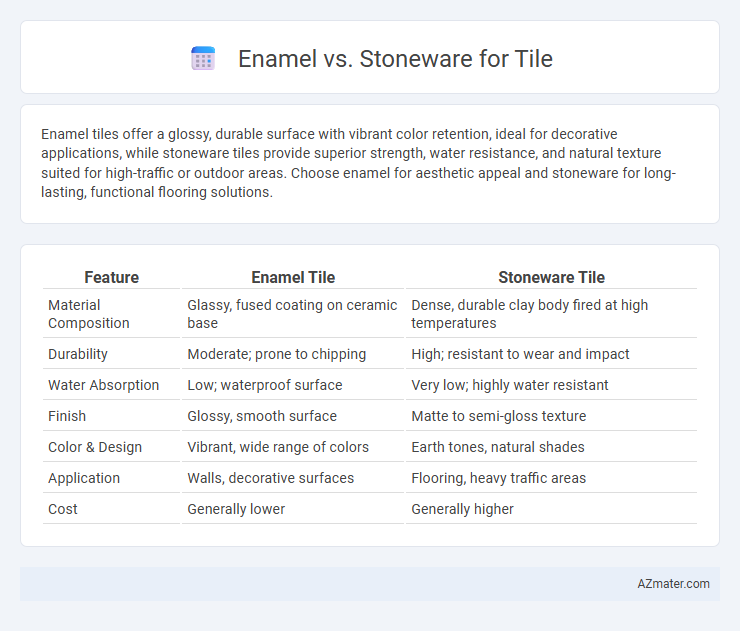Enamel tiles offer a glossy, durable surface with vibrant color retention, ideal for decorative applications, while stoneware tiles provide superior strength, water resistance, and natural texture suited for high-traffic or outdoor areas. Choose enamel for aesthetic appeal and stoneware for long-lasting, functional flooring solutions.
Table of Comparison
| Feature | Enamel Tile | Stoneware Tile |
|---|---|---|
| Material Composition | Glassy, fused coating on ceramic base | Dense, durable clay body fired at high temperatures |
| Durability | Moderate; prone to chipping | High; resistant to wear and impact |
| Water Absorption | Low; waterproof surface | Very low; highly water resistant |
| Finish | Glossy, smooth surface | Matte to semi-gloss texture |
| Color & Design | Vibrant, wide range of colors | Earth tones, natural shades |
| Application | Walls, decorative surfaces | Flooring, heavy traffic areas |
| Cost | Generally lower | Generally higher |
Introduction to Enamel and Stoneware Tiles
Enamel tiles feature a glassy, smooth surface created by fusing powdered glass to a substrate through high-temperature firing, resulting in a durable, vibrant finish ideal for both indoor and outdoor use. Stoneware tiles are made from dense, non-porous clay fired at high temperatures, offering exceptional strength and resistance to moisture, making them suitable for high-traffic areas and wet environments. Both enamel and stoneware tiles provide versatile design options, with enamel excelling in color variety and gloss, while stoneware delivers natural textures and earthy tones.
Composition and Material Differences
Enamel tiles consist of a glassy coating fused onto a metal or ceramic base, providing a smooth, glossy finish with high resistance to stains and moisture. Stoneware tiles are made from dense, non-porous clay fired at high temperatures, delivering exceptional durability and natural texture suited for heavy-use areas. The primary material difference lies in enamel's glass-based coating for added surface protection, whereas stoneware relies on its dense ceramic body for strength and longevity.
Durability and Strength Comparison
Enamel tiles offer a hard, glossy surface that resists scratches and stains but can chip or crack under heavy impact, limiting their durability in high-traffic areas. Stoneware tiles, made from dense, fired clay, provide exceptional strength and resistance to wear, making them ideal for both indoor and outdoor applications requiring long-lasting performance. The choice between enamel and stoneware tiles depends on the balance between aesthetic appeal and the need for robust, impact-resistant materials.
Surface Finish and Aesthetic Appeal
Enamel tiles offer a smooth, glossy surface finish that enhances color vibrancy and provides a sleek, modern aesthetic ideal for contemporary interiors. Stoneware tiles feature a naturally textured, matte surface with earthy tones and subtle variations, creating a rustic, organic appeal often preferred in traditional or rustic designs. The choice between enamel and stoneware tiles significantly impacts the overall look and feel of a space, with enamel emphasizing brightness and polish, while stoneware highlights natural beauty and tactile depth.
Water Absorption and Stain Resistance
Enamel tiles exhibit low water absorption rates, typically below 0.5%, making them highly resistant to moisture and ideal for wet areas. Stoneware tiles also offer low water absorption, ranging from 0.5% to 3%, but they generally require sealing to maintain stain resistance over time. Both materials provide durable surfaces, though enamel's vitrified glaze enhances stain resistance, whereas stoneware's porous structure can absorb stains if not properly treated.
Installation Considerations
Enamel tiles require careful handling due to their prone-to-chipping surface, making precise alignment and minimal cutting essential during installation. Stoneware tiles offer easier installation with their durability and resistance to cracks, allowing for more flexibility in cutting and placement. Choosing stoneware reduces the risk of damage and installation errors, while enamel demands skilled labor to maintain its glossy finish and avoid surface scratches.
Cost and Budget Factors
Enamel tiles generally offer a lower initial cost compared to stoneware tiles, making them a budget-friendly option for large-scale projects or renovations. Stoneware tiles, known for their durability and natural aesthetic, tend to have a higher price point but provide better long-term value due to their resistance to chipping and wear. When budgeting, consider enamel tiles for affordable and versatile designs, while stoneware is preferable for investment in longevity and premium finishes.
Maintenance and Cleaning Requirements
Enamel tiles require gentle cleaning with non-abrasive cleaners to prevent surface scratching, while stoneware tiles are more durable and resistant to stains, allowing for easier maintenance with mild detergent and water. Enamel's glossy surface may show fingerprints and smudges more readily, needing frequent wiping, whereas stoneware's textured, matte finish naturally conceals dirt. Both materials benefit from regular sealing--stoneware especially--to protect against moisture penetration and prolong tile lifespan.
Best Applications for Enamel and Stoneware Tiles
Enamel tiles are best suited for high-moisture areas such as bathrooms and kitchens due to their water-resistant and glossy surface that prevents stains and facilitates easy cleaning. Stoneware tiles excel in heavy-traffic zones like hallways and commercial spaces because of their durability, strength, and resistance to wear and impact. Both enamel and stoneware tiles offer distinct advantages that align with specific application needs, ensuring long-lasting performance and aesthetic appeal.
Choosing the Right Tile for Your Project
Enamel tiles offer a glossy, durable surface resistant to stains and scratches, making them ideal for high-traffic areas and moisture-prone environments. Stoneware tiles provide a natural, textured finish with exceptional strength and heat resistance, suitable for both indoor and outdoor applications. Choosing the right tile depends on project requirements such as aesthetics, durability, maintenance needs, and environmental exposure to ensure optimal performance and longevity.

Infographic: Enamel vs Stoneware for Tile
 azmater.com
azmater.com